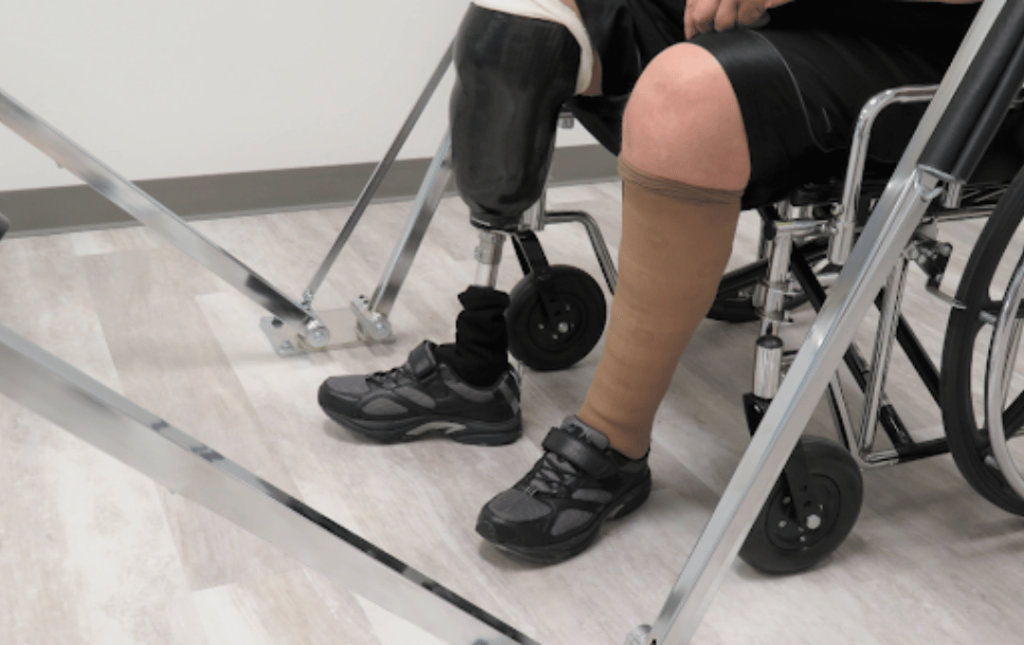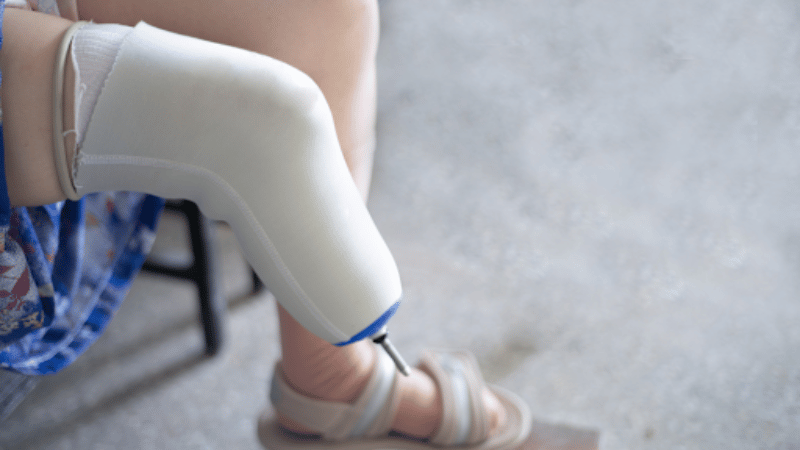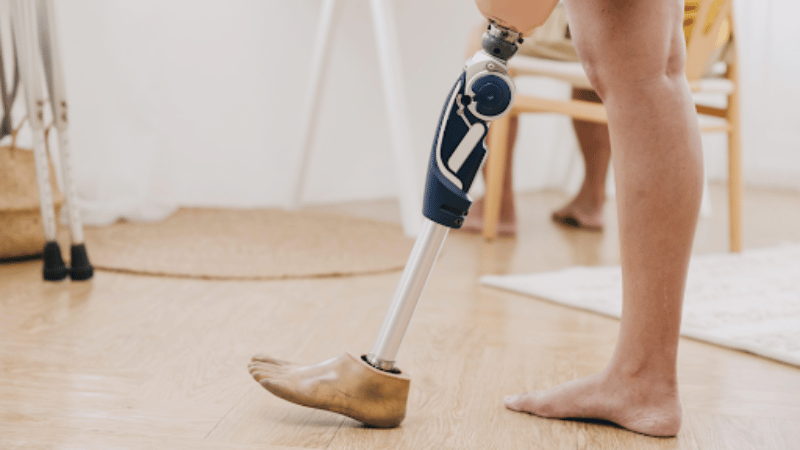Did you know peripheral artery disease (PAD) impacts more than 250 million people worldwide? Of this number, it’s expected that over 20% of these individuals are also living with diabetes.¹
PAD and diabetes are inextricably linked: diabetes affects your body’s ability to control blood sugar levels and is characterized by high blood sugar, high cholesterol, and insulin resistance. These factors can damage the arteries, leading to an increased opportunity for plaque buildup on the arterial walls. When this happens, reduced blood flow from PAD can make it even harder to keep the lower limbs healthy in diabetic patients.
Diabetic amputations are one of the most common complications of diabetes. While lifestyle modifications can help lower the risk of amputation, you should take some time to educate yourself on the symptoms and warning signs if you’re a high-risk patient.
In this article, we’ll look at some diabetes amputation statistics and explore the connection between PAD and diabetes. Here’s everything you need to know:
10 PAD and Diabetic Amputation Statistics
Every year in the United States, about 120,000 amputations of the lower limb not related to trauma are performed on people with diabetes. Advanced PAD can also lead to amputation due to critical limb ischemia (CLI). Critical Limb Ischemia (CLI) is a severe blockage of blood flow to the legs and feet, often leading to chronic wounds or infections. In people with diabetes, CLI increases the risk of developing foot ulcers and infections due to poor circulation, which may eventually lead to amputation if untreated.
The connection between CLI, diabetes, and Peripheral Artery Disease (PAD) is critical, as PAD worsens blood flow issues in diabetic patients, accelerating the development of CLI and increasing the likelihood of limb complications.
Here’s a list of 10 PAD and diabetic amputation statistics you should know:
- Diabetes-related foot syndrome patients with PAD are at a higher risk for non-healing foot wounds and amputation than PAD patients without neuropathy.1
- Nearly a half a billion people worldwide are living with diabetes and this number is expected to increase by more than 50% over the next 25 years.2
- Diabetes is the leading cause of non-traumatic lower-limb amputation in the United States.3
- Peripheral artery disease affects between 8 and 10 million people in the United States alone.4
- One in every 20 Americans over the age of 50 has P.A.D.4
- Approximately 15% of patients with diabetes also have a foot ulcer.5
- Of these 15%, about 14-24% will require amputation.5
- Around 75% of diabetic foot ulcers may be preventable.6
- 30% of patients will need life-saving amputation of a limb within a year of critical limb ischemia (CLI) diagnosis.7
- Critical Limb Ischemia (CLI) is found in 12% of the U.S. adult population.8
Even though many of these statistics are alarming, raising awareness of PAD and diabetic amputation can go a long way toward preventing foot ulcers and amputation.
The Connection Between Peripheral Artery Disease (PAD) and Diabetic Amputations
Individuals with diabetes are more likely to have high blood sugar, which can lead to complications with high blood pressure. This connection occurs because the body’s ability to regulate blood sugar is impaired, often affecting overall cardiovascular health. High blood sugar levels can cause poor circulation and nerve damage and contribute to the development of peripheral artery disease.
For this reason, individuals with diabetes are at a higher risk of developing PAD. Diabetes can lead to damage in blood vessels, reducing circulation and increasing the likelihood of plaque buildup in the arteries. As a result, one in every three individuals over the age of 50 with diabetes is likely to have PAD.²
PAD is a serious vascular disease that is caused by plaque buildup in the arteries. When the plaque builds up, the arteries narrow, preventing the flow of blood, oxygen, and nutrients to the lower extremities. These conditions present a severe risk to limb health, especially for patients who also have diabetes.
PAD is a progressive disease that cannot be reversed. The earlier that a PAD patient with diabetes seeks treatment, the more likely they are to avoid serious complications like diabetic foot amputation.
Diabetic Foot and Leg Amputations
Diabetes can lead to foot and leg amputations due to poor circulation and nerve damage in the legs and feet. This makes it difficult for leg wounds or ulcers to heal properly. If these wounds become infected and left untreated, amputation may be necessary to prevent further complications. Regularly monitoring your vascular health is essential for individuals with diabetes to reduce the risk of amputation.
Preventative Measures and Early Detection for Diabetes & PAD
If you have diabetes or PAD, there are preventative measures you can take to improve your quality of life and prevent disease progression. The following lifestyle recommendations can help improve circulation in the legs and avoid vascular damage:
- Avoid smoking.
- Follow an exercise program.
- Eat a balanced diet.
- Manage glucose levels effectively.
- Take medication to lower blood sugar, high blood pressure, or cholesterol.
It’s also important to know the warning signs of diabetes and PAD so you’ll know when to schedule a consultation with a vascular specialist. Some of the warning signs of PAD include:
- Numbness or tingling in the lower extremities
- Coldness in your legs or feet
- A change in skin color
- Puffiness in the lower legs (lower extremity edema)
- Slowed hair or toenail growth
Taking proactive steps toward managing your health can significantly impact your long-term well-being. Adopting healthy lifestyle habits and staying vigilant about any changes in your symptoms can help reduce the risk of complications and improve your overall vascular health. If you notice any warning signs or experience discomfort in your legs or feet, don’t wait—consulting a vascular specialist early can help you prevent further disease progression and ensure you receive the care you need.
Minimally Invasive Treatments for PAD
One of the most effective ways to prevent or treat PAD and diabetic foot ulcers is to improve leg circulation. At USA Vascular Centers, we have three main approaches to PAD treatment:
- Angioplasty: Uses a balloon-tipped catheter to compress the plaque against artery walls
- Stent placement: Puts a mesh stent into the artery to keep it propped open
- Atherectomy: Cuts plaque into small pieces with a laser or blade before safely removing it from the body
When you meet with a doctor at USA Vascular Centers, they will discuss your symptoms and decide which minimally invasive procedure is right for you.
Schedule a Consultation with USA Vascular Centers
Are you currently exhibiting signs of PAD? Schedule a consultation with USA Vascular Centers today.
Our state-of-the-art outpatient centers are accredited by the AAAHC, which means we adhere to the highest standards for quality care. Our clinic accepts most insurance options, along with Medicare and Medicaid. You can use our online scheduling tool to verify your insurance.
Call us at 888.773.2193 today to schedule a consultation.
Find the CENTER Closest To You
Frequently Asked Questions
Can diabetes lead to leg amputation?
Yes, leg amputation is a primary concern for individuals with diabetes. Increased blood sugar levels can cause peripheral nerve damage or PAD. If left untreated, this can lead to a leg amputation.
When does a diabetic foot need to be amputated?
A diabetic amputation is necessary if the leg cannot be saved due to infection, tissue damage, or tissue loss.
What causes foot amputation in diabetics?
The two most common causes are peripheral artery disease and diabetic neuropathy.
Why do diabetics lose limbs?
Poor circulation, nerve damage, foot ulcers, sores, and wounds are the primary reasons diabetics need an amputation. These complications can lead to life-threatening tissue damage and infections.
Sources:
- Gerhard Rümenapf et al., “Peripheral arterial disease and the diabetic foot syndrome: Neuropathy makes the difference! A narrative review,” Journal of Clinical Medicine, https://doi.org/10.3390/jcm13072141
- Pouya Saeedi et al., “Global and regional diabetes prevalence estimates for 2019 and projections for 2030 and 2045: Results from the International Diabetes Federation Diabetes Atlas, 9th edition,” Diabetes Research and Clinical Practice, https://pubmed.ncbi.nlm.nih.gov/31518657/
- Foluso Fakorede, “Reducing disparities in diabetic amputations,” National Institute of Diabetes and Digestive and Kidney Diseases, https://www.niddk.nih.gov/health-information/professionals/diabetes-discoveries-practice/reducing-disparities-in-diabetic-amputations
- Jessica L Harding, et al., “National and state-level trends in nontraumatic lower-extremity amputation among U.S. Medicare beneficiaries with diabetes, 2000-2017,” Diabetes Care, https://pubmed.ncbi.nlm.nih.gov/32723844/
- U.S. DEPARTMENT OF HEALTH AND HUMAN SERVICES, National Institutes of Health, & National Heart, Lung, and Blood Institute. (n.d.). Facts about Peripheral arterial Disease (P.A.D.). In National Institutes of Health. https://www.nhlbi.nih.gov/sites/default/files/publications/06-5837_0.pdf
- Diabetic foot ulcer: A comprehensive review of pathophysiology and management modalities. (n.d.). PMC PubMed Central. https://www.ncbi.nlm.nih.gov/pmc/articles/PMC10037283/
- Sicco A Bus & Jaap J van Netten, “A shift in priority in diabetic foot care and research: 75% of foot ulcers are preventable,” Diabetes/Metabolism Research & Reviews, https://onlinelibrary.wiley.com/doi/10.1002/dmrr.2738
- Criticial Limb Ischemia: Epidemiology. (n.d.). PMC PubMed Central. https://www.ncbi.nlm.nih.gov/pmc/articles/PMC3549644/





